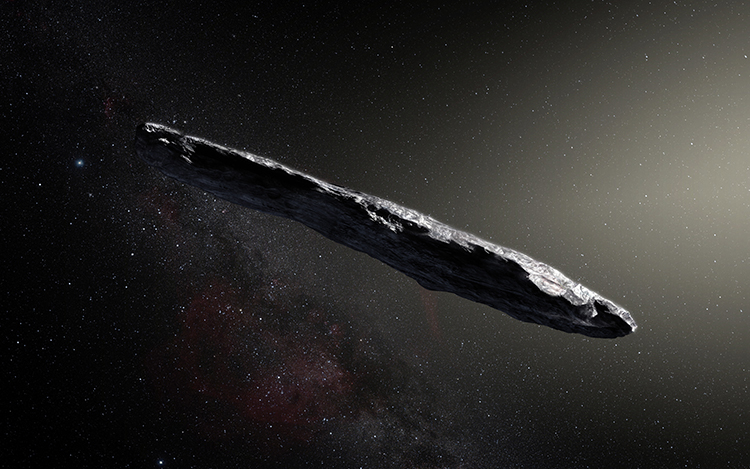On October 19, 2017, astronomers discovered the first interstellar object ever known to have visited our solar system. An asteroid bestowed with the Hawaiian name ‘Oumuamua, meaning “scout,” it was initially detected as a fast-moving point of light between the orbits of Earth and Mars by the Pan-STARRS telescope in Hawaii. Several ground-based telescopes around the world then made subsequent, detailed observations before the asteroid became lost to view during its rapid return to interstellar space. This observation campaign brought forth another surprise: ‘Oumuamua is approximately 10 times as long as it is wide, giving it a cigar-like shape unlike any other cosmic body on record. See also: Asteroid; Comet; Solar system; Telescope

Overall, ‘Oumuamua measures some 400 meters in length and a few dozen meters wide. Scientists do not know what processes could have created it in its home solar system, nor precisely where that system might be. In other ways, though, ‘Oumuamua resembles familiar asteroids. It has a reddish hue, probably due to carbon-containing material on its surface, much like the bodies found most prevalently in the outer region of the Asteroid Belt between Mars and Jupiter, as well as in the Kuiper Belt where Pluto resides. ‘Oumuamua showed no signs of dust or gases streaming off of it into space, as does occur with comets. The observations therefore suggest that the object is dense and rocky without any ices on its exterior. See also: Jupiter; Kuiper Belt; Mars; Pluto; Volatilization
Approximately 750,000 asteroids and comets are known to exist in our solar system. Scientists study these space rocks because they are remnants of our solar system’s formation 4.6 billion years ago. In this way, asteroids and comets act like time capsules, preserving key information about the initial molecular ingredients and cosmic conditions that ultimately allowed for the development of multiple planets, moons, and—on at least one world, Earth—biological life. The insights gained from extraplanetary objects native to the solar system point to why the discovery of ‘Oumuamua is so scientifically compelling. Gathering and analyzing data about it and future interstellar out-of-towners will expand knowledge about other solar systems, of which the Milky Way Galaxy alone is estimated to host billions. See also: Astrobiology; Biology; Extrasolar planets; Galaxy, external; Milky Way Galaxy; Molecule; Planet
Researchers expect that interstellar asteroids thrown out by gravitational interactions in their home solar systems probably pass by Earth several times a year. Yet because the asteroids are both faint and high-velocity, detecting them poses a significant challenge. The ongoing deployment of sensitive, automated sky survey projects, like Pan-STARRS, however, should reveal many more of these sorts of transient objects in coming years. Although it is the first ever documented, ‘Oumuamua surely will not be the last foreign asteroid seen paying a visit to our solar system. See also: Celestial mechanics; Gravity





